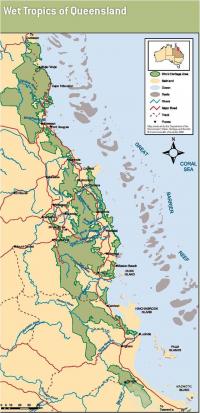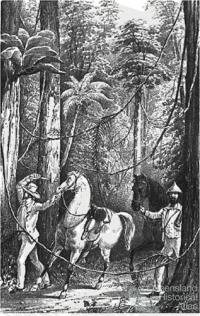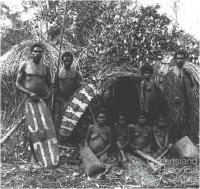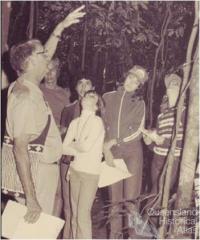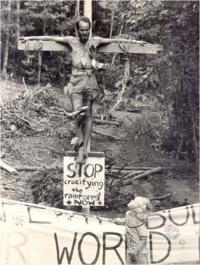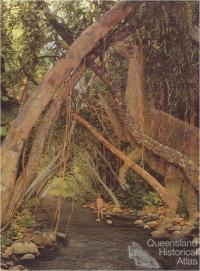- Home
- Quintessential Queensland
- Distinctiveness
- Perceptions
- Perceptions: how people understand the landscape
- From runs to closer settlement
- Geological survey of Queensland
- Mapping a new colony, 1860-80
- Mapping the Torres Strait: from TI to Magani Malu and Zenadh Kes
- Order in Paradise: a colonial gold field
- Queensland atlas, 1865
- Queensland mapping since 1900
- Queensland: the slogan state
- Rainforests of North Queensland
- Walkabout
- Queenslanders
- Queenslanders: people in the landscape
- Aboriginal heroes: episodes in the colonial landscape
- Australian South Sea Islanders
- Cane fields and solidarity in the multiethnic north
- Chinatowns
- Colonial immigration to Queensland
- Greek Cafés in the landscape of Queensland
- Hispanics and human rights in Queensland’s public spaces
- Italians in north Queensland
- Lebanese in rural Queensland
- Queensland clothing
- Queensland for ‘the best kind of population, primary producers’
- Too remote, too primitive and too expensive: Scandinavian settlers in colonial Queensland
- Distance
- Movement
- Movement: how people move through the landscape
- Air travel in Queensland
- Bicycling through Brisbane, 1896
- Cobb & Co
- Journey to Hayman Island, 1938
- Law and story-strings
- Mobile kids: children’s explorations of Cherbourg
- Movable heritage of North Queensland
- Passages to India: military linkages with Queensland
- The Queen in Queensland, 1954
- Transient Chinese in colonial Queensland
- Travelling times by rail
- Pathways
- Pathways: how things move through the landscape and where they are made
- Aboriginal dreaming paths and trading ways
- Chinese traders in the nineteenth century
- Introducing the cane toad
- Pituri bag
- Press and the media
- Radio in Queensland
- Red Cross Society and World War I in Queensland
- The telephone in Queensland
- Where did the trams go?
- ‘A little bit of love for me and a murder for my old man’: the Queensland Bush Book Club
- Movement
- Division
- Separation
- Separation: divisions in the landscape
- Asylums in the landscape
- Brisbane River
- Changing landscape of radicalism
- Civil government boundaries
- Convict Brisbane
- Dividing Queensland - Pauline Hanson’s One Nation Party
- High water mark: the shifting electoral landscape 2001-12
- Hospitals in the landscape
- Indigenous health
- Palm Island
- Secession movements
- Separate spheres: gender and dress codes
- Separating land, separating culture
- Stone walls do a prison make: law on the landscape
- The 1967 Referendum – the State comes together?
- Utopian communities
- Whiteness in the tropics
- Conflict
- Conflict: how people contest the landscape
- A tale of two elections – One Nation and political protest
- Battle of Brisbane – Australian masculinity under threat
- Dangerous spaces - youth politics in Brisbane, 1960s-70s
- Fortress Queensland 1942-45
- Grassy hills: colonial defence and coastal forts
- Great Shearers’ Strike of 1891
- Iwasaki project
- Johannes Bjelke-Petersen: straddling a barbed wire fence
- Mount Etna: Queensland's longest environmental conflict
- Native Police
- Skyrail Cairns (Research notes)
- Staunch but conservative – the trade union movement in Rockhampton
- The Chinese question
- Thomas Wentworth Wills and Cullin-la-ringo Station
- Separation
- Dreaming
- Imagination
- Imagination: how people have imagined Queensland
- Brisbane River and Moreton Bay: Thomas Welsby
- Changing views of the Glasshouse Mountains
- Imagining Queensland in film and television production
- Jacaranda
- Literary mapping of Brisbane in the 1990s
- Looking at Mount Coot-tha
- Mapping the Macqueen farm
- Mapping the mythic: Hugh Sawrey's ‘outback’
- People’s Republic of Woodford
- Poinsettia city: Brisbane’s flower
- The Pineapple Girl
- The writers of Tamborine Mountain
- Vance and Nettie Palmer
- Memory
- Memory: how people remember the landscape
- Anna Wickham: the memory of a moment
- Berajondo and Mill Point: remembering place and landscape
- Cemeteries in the landscape
- Landscapes of memory: Tjapukai Dance Theatre and Laura Festival
- Monuments and memory: T.J. Byrnes and T.J. Ryan
- Out where the dead towns lie
- Queensland in miniature: the Brisbane Exhibition
- Roadside ++++ memorials
- Shipwrecks as graves
- The Dame in the tropics: Nellie Melba
- Tinnenburra
- Vanished heritage
- War memorials
- Curiosity
- Curiosity: knowledge through the landscape
- A playground for science: Great Barrier Reef
- Duboisia hopwoodii: a colonial curiosity
- Great Artesian Basin: water from deeper down
- In search of Landsborough
- James Cook’s hundred days in Queensland
- Mutual curiosity – Aboriginal people and explorers
- Queensland Acclimatisation Society
- Queensland’s own sea monster: a curious tale of loss and regret
- St Lucia: degrees of landscape
- Townsville’s Mount St John Zoo
- Imagination
- Development
- Exploitation
- Transformation
- Transformation: how the landscape has changed and been modified
- Cultivation
- Empire and agribusiness: the Australian Mercantile Land and Finance Company
- Gold
- Kill, cure, or strangle: Atherton Tablelands
- National parks in Queensland
- Pastoralism 1860s–1915
- Prickly pear
- Repurchasing estates: the transformation of Durundur
- Soil
- Sugar
- Sunshine Coast
- The Brigalow
- Walter Reid Cultural Centre, Rockhampton: back again
- Survival
- Survival: how the landscape impacts on people
- Brisbane floods: 1893 to the summer of sorrow
- City of the Damned: how the media embraced the Brisbane floods
- Depression era
- Did Clem Jones save Brisbane from flood?
- Droughts and floods and rail
- Missions and reserves
- Queensland British Food Corporation
- Rockhampton’s great flood of 1918
- Station homesteads
- Tropical cyclones
- Wreck of the Quetta
- Pleasure
- Pleasure: how people enjoy the landscape
- Bushwalking in Queensland
- Cherbourg that’s my home: celebrating landscape through song
- Creating rural attractions
- Festivals
- Queer pleasure: masculinity, male homosexuality and public space
- Railway refreshment rooms
- Regional cinema
- Schoolies week: a festival of misrule
- The sporting landscape
- Visiting the Great Barrier Reef
By:
Russell McGregor Environmental perceptions are seldom straightforward. From their first intrusions into the North Queensland rainforests in the mid-nineteenth century, European people have been both attracted and repelled, admiring the natural resplendence of the forests while yearning to transform the dank, dripping jungle into something more fitted for their own habitation. Environmental historian Kevin Frawley has identified three major strands of perception of the northern rainforests: aesthetic, utilitarian and scientific. One or another of these strands may have been dominant at a particular time, but all were woven – or tangled – together in the myriad ways in which European people have seen the northern rainforests.
Admiration and exploitation
Early European observers, like their counterparts today, were struck by the beauties of the rainforest. George Elphinstone Dalrymple, who led the first systematic explorations of the North Queensland rainforests in 1873, extolled their beauty in purple prose infused with a late Romantic sensibility. The adventurer-explorer Archibald Meston rendered the rainforest still more lavishly. Reporting on his 1889 ascent of Mount Bellenden-Ker, Meston wrote that he:
stood entranced in the presence of this magnificent and wonderful scene, that rivals in its living reality all that Romance, the ‘parent of golden dreams’, ever pictured in the fancy of the poet and the painter.
Other colonial commentators, like the visiting Norwegian zoologist Carl Lumholtz, wrote less lushly, but still expressed admiration for the natural wonders of the rainforest. They also conveyed the clear message that while the rainforests were beautiful to behold, they were not a nice place to live in.
Alongside aesthetic appreciations of the rainforests, these early observers expressed decidedly utilitarian aspirations. Dalrymple saw not only the beauties of the rainforest; he saw through the trees, into the soil beneath. In line with the scientific wisdom of the day, Dalrymple interpreted the luxuriance of the forests as indicative of the richness of the soil, hence its potential for tropical agriculture. Queensland’s Colonial Botanist, Walter Hill, who accompanied Dalrymple on his 1873 expedition, agreed. Their published accounts of the trees and soils of the coastal rainforests inspired first cedar-cutters, then farmers, to exploit the resources of the valleys of the Johnstone, Daintree and other northern rivers.
Conservancy to ecology
Walter Hill and his successor as Colonial Botanist, Frederick Manson Bailey, were advocates of what we would today call ‘wise-use conservation’. While encouraging the transformation of rainforest lands into agricultural landscapes, they urged that the transformation be carried out in an orderly and regulated manner, integrating as much as possible of the earlier vegetative environment into the new regime under cultivation. Against this stood a popular assumption that the resources of rainforest lands were boundless. The latter, combined with a governmental commitment to an ideology of closer settlement, led to large-scale clearance of the forest and frequent squandering of its timber and other resources.
Late-nineteenth century scientists tended to see rainforests as vast assemblages of discrete species rather than in terms of the interrelationships among them. It was a view that meshed with the prevailing utilitarian ethos. From the early twentieth century, ecological understandings of the rainforests were advanced, growing in prominence after the 1940s especially through the studies of CSIRO scientists Len Webb and Geoff Tracey. Emphasising the interdependence of all living things, ecology encouraged respect for the natural integrity of the rainforests and demands for their preservation. It was primarily for their ecological importance and biodiversity that the Wet Tropics of Queensland were inscribed on UNESCO’s World Heritage list in 1988 although aesthetic values also figured prominently among the criteria for listing.
Tourists and protestors
As early as 1889 Archibald Meston predicted that the rainforests near Cairns would soon attract hordes of scenery-seeking tourists – though only to lament that ‘the tourist Goths and Vandals’ of the future would despoil the place by strewing ‘their abominable sandwich wrappers, and infernal rum bottles over this splendid picture in the art gallery of Nature!’ Tourists – with or without their litter – soon came. Opened in 1891, the railway from Cairns to Kuranda, which snakes up rainforest-clad mountains, across gorges and waterfalls, quickly became a tourist drawcard. By the early twentieth century the Queensland government was promoting the northern rainforests as tourist attractions and numerous entrepreneurs found new ways to convert rainforest into profit. While tourist promotional material was framed within a romantic aesthetic emphasising the grandeur of nature, the tourist industry flourished best after the rainforest had been tamed, reduced to patches interspersed among farms and towns.
Tourist operators sought to preserve the more scenically spectacular bits of the rainforest, but others held more ambitiously preservationist agendas. The North Queensland Naturalists’ Club, founded in 1932, advanced ethical as well as aesthetic and scientific arguments for the conservation of the ‘natural heritage’ of the region’s rainforests. The ethical imperative intensified with the rise of a global Green movement in the 1970s. Claiming the world’s rainforests to be in a state of crisis, Green activists insisted that tropical rainforests should be valued not so much for their attractiveness or usefulness to human beings as for their intrinsic worth as ‘wilderness’. In North Queensland, the advent of this new Green ideology was dramatically played out in the 1983-84 blockading of a road which was being pushed through the Daintree rainforests.
Seeing the rainforest
From the mid-nineteenth to the mid-twentieth centuries, the North Queensland rainforest was considered an ‘alien’ flora which had recently (in geological terms) invaded from Southeast Asia and was unrelated to the ‘genuinely Australian’ sclerophyll vegetation. This was a simplification of the theories propounded in the 1860s by the leading British botanist, Joseph Hooker, but it took root in Australia at a time of growing fears of another – human – invasion from Asia. In the second half of the twentieth century, under the combined influence of ecological studies and the theory of continental drift, the ‘alien invasives’ interpretation gave way to the idea that Australia’s rainforests were an ancient flora with a lineage going back to a time before this continent had separated from Gondwanaland.
While the northern rainforests were indigenised by being embedded in deep geological time, they were Indigenised in another sense through increasing attentiveness to their Aboriginal heritage. Rainforest Aboriginal people and cultures had long fascinated European observers. Dalrymple and other observers of the rainforest encountered many Aboriginal people and as early as the 1930s, a tourist enterprise known as the Malanda Jungle staged displays of Aboriginal skills and culture, performed by local Mamu and Ngadjon people. From the 1970s, popular interest in seeing the rainforest as an Aboriginal environment flourished, and at the same time local Aboriginal people began to assert control over how their relationship with the rainforest was projected to a wider audience. Founded in 1987, the Tjapukai Aboriginal Cultural Park north of Cairns has conveyed to millions of Australian and international tourists the message that aesthetic, spiritual and utilitarian appreciations of the rainforests are not an exclusively European preserve.
References and Further reading (Note):
Kevin Frawley, ‘An ancient assemblage: the Australian rainforests in European conceptions of nature’, Continuum: the Australian journal of media and culture, 3:1, 1990
References and Further reading (Note):
Carl Lumholtz, Among cannibals: an account of four years’ travels in Australia and of camp life with the Aborigines of Queensland, London, John Murray, 1889
References and Further reading (Note):
Archibald Meston, Report of the Government Scientific Expedition to Bellenden-Ker Range upon the flora and fauna of that part of the colony, Brisbane, Government Printer, 1889
References and Further reading (Note):
Rod Ritchie, Seeing the rainforests in 19th-century Australia, Sydney, Rainforest Publishing, 1989
References and Further reading (Note):
Rachel Sanderson, ‘Tangled visions: changing scientific understandings of the north Queensland rainforests, 1770-1990', PhD thesis, James Cook University, 1990. Available at: http://eprints.jcu.edu.au/2092/
References and Further reading (Note):
G. Elphinstone Dalrymple, Narrative and reports of the Queensland north-east coast expedition, 1873, Brisbane, Government Printer, 1874

